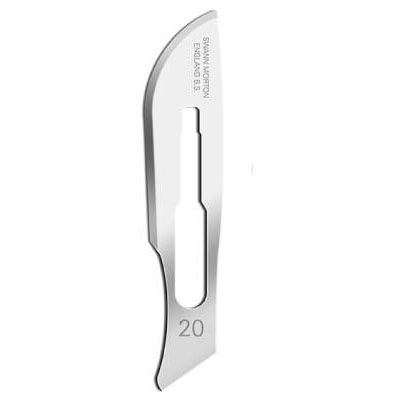Swann Morton Blue Blades. Carbon steel, sterile in individual peel packs.
Swann Morton Blue Blades. Carbon steel, non-sterile in individual peel packs. Perfect for podiatry and chiropody procedures.
Product Description
Swann Morton Blue Blades Features:
Supplied in boxes of 100 in individual peel packs, these blades are intended for single use, and should not be autoclaved. Autoclaving these blades with other instruments will cause rust stains on other stainless steel instruments.
Specification:
- Non-Sterile.
- Carbon Steel.
The No.10 blade with its curved cutting edge is one of the more traditional blade shapes and is used generally for making varying sizes of incision in skin and muscle. The No.10 is often utilised in more specialised surgeries. The No.10 fits Handles 3, 3L, 3 Graduated, 5B, 7, 9 and B3.
The No.10A is a straight edged blade with a strong tip and fits Handles 3, 3L, 3 Graduated, 5B, 7, 9 and B3.The Swann-Morton 10A blade is perfect for minor surgical procedures, like digging out splinters and thorns.
The No.11 is an elongated triangular blade sharpened along the hypotenuse edge with a strong pointed tip making it ideal for stab incisions needed when lancing an abscess. It is held like a pencil and often upside down by the surgeon to prevent it inadvertently being inserted too deep. To avoid this scenario the scalpel should not be held towards the back end whilst the heel of the hand should be placed on the skin thus stabilising the hand to help prevent an unwanted deep incision. The No.11 is also used for other small incisions for example in vein and artery central lines, anatomical dissections and surgical treatment of disorders of the foot, ankle and lower extremities in Podiatry. The No.11 blades fit Handles 3, 3L, 3 Graduated, 5B, 7, 9 and B3.
The No.15 blade has a small, curved cutting edge and is the most popular blade shape ideal for making short and precise incisions. It is utilised in a variety of surgical procedures including the excision of a skin lesion or recurrent sebaceous cyst. The No.15 fits Handles 3, 3L, 3 Graduated, 5B, 7, 9, B3 and B3L.
The No.15T blade has a short rounded cutting edge combined with an angled point provide additional strength to this blade making it ideal for fine procedures in the hand and foot such as debridement (removal of dead, damaged or infected skin tissues) and heloma enucleation ( removal of a soft or artificial corn without damaging the surrounding tissue). Fitment No.3. Fits Handles 3, 3L, 3 Graduated, 5B, 7, 9, B3 and B3L.
The No.20 is a large version of the No.10 blade with a curved cutting edge and a flat, unsharpened back edge. Used for orthopaedic and general surgical procedures it fits handle No. 4, 4L, 4 Graduated & 6B.
The No.21 is a large version of the No.10 blade with a curved cutting edge and a flat, unsharpened back edge. Larger than the No.20 but smaller than the No.22 the No.21 fits handles 4, 4L, 4 Graduated & 6B.
The No.22 is a large version of the No.10 blade with a curved cutting edge and a flat, unsharpened back edge. Used for skin incisions. Larger than the No.20 and No.21 the No.22 fits handles 4, 4L, 4 Graduated & 6B
The No.22A is a Fitment No.4. and fits handles 4, 4L, 4 Graduated & 6B.
The No.23 is a "leaf-shaped" blade sharpened along its leading edge. Used for making long incisions. Fits handles 4, 4L, 4 Graduated & 6B.
Slightly larger than the No.23 blade, the No.24 is more semi-circular in shape and is again sharpened along its leading edge. Used for making long incisions in general surgery. Fits handles 4, 4L, 4 Graduated & 6B.




